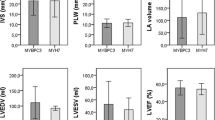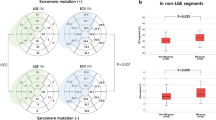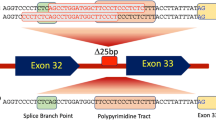Abstract
Mutations in sarcomeric genes are common genetic cause of cardiomyopathies. An intronic 25-bp deletion in cardiac myosin binding protein C (MYBPC3) at 3 ′ region is associated with dilated and hypertrophic cardiomyopathies in Southeast Asia. However, the frequency of sarcomeric gene polymorphisms and associated clinical presentation have not been established with left ventricular dysfunction (LVD). Therefore, the aim of the present study was to explore the association of MYBPC3 25-bp deletion, titin (TTN) 18 bp I/D , troponin T type 2 (TNNT2) 5 bp I/D and myospryn K2906N polymorphisms with LVD. This study includes 988 consecutive patients with angiographically confirmed coronary artery disease (CAD) and 300 healthy controls. Among the 988 CAD patients, 253 with reduced left ventricle ejection fraction (LVEF ≤ 45%) were categorized as LVD. MYBPC3 25-bp deletion, TTN 18 bp I/D and TNNT2 5 bp I/D polymorphisms were determined by direct polymerase chain reaction method, while myospryn K2906N polymorphism by TaqMan assay. Our results showed that MYBPC3 25-bp deletion polymorphism was significantly associated with elevated risk of LVD (LVEF <45) (healthy controls versus LVD: OR = 3.85, P< 0.001; and nonLVD versus LVD: OR = 1.65, P = 0.035), while TTN 18 bp I/D , TNNT2 5 bp I/D and myospryn K2906N polymorphisms did not show any significant association with LVD. The results also showed that MYBPC3 25-bp deletion polymorphism was significantly associated with other parameters of LV remodelling, i.e. LV dimensions (LV end diastole dimension, LVEDD: P = 0.037 and LV end systolic dimension, LVESD: P = 0.032). Our data suggests that MYBPC3 25-bp deletion may play significant role in conferring LVD as well as CAD risk in north Indian population.



Similar content being viewed by others
References
Bienengraeber M., Olson T. M., Selivanov V. A., Kathmann E. C., O’Cochlain F., Gao F. et al. 2004 ABCC9 mutations identified in human dilated cardiomyopathy disrupt catalytic KATP channel gating. Nat. Genet. 36, 382–387.
Bulteau A. L., Szweda L. I. and Friguet B. 2002 Age-dependent declines in proteasome activity in the heart. Arch. Biochem. Biophys. 397, 298–304.
Deepa S. R., Nallari P., Dhandapany P. S., Tamilarasi S., Shah A., Archana V. et al. 2012 Cardiac troponin T (TNNT2) mutations are less prevalent in Indian hypertrophic cardiomyopathy patients. DNA Cell Biol. 31, 616–624.
Devereux R. B., Alonso D. R., Lutas E. M., Gottlieb G. J., Campo E., Sachs I. et al. 1986 Echocardiographic assessment of left ventricular hypertrophy: comparison to necropsy findings. Am. J. Cardiol. 57, 450–458.
Devlin B. and Roeder K. 1999 Genomic control for association studies. Biometrics 55, 997–1004.
Dhandapany P. S., Sadayappan S., Xue Y., Powell G. T., Rani D. S., Nallari P. et al. 2009 A common MYBPC3 (cardiac myosin binding protein C) variant associated with cardiomyopathies in south Asia. Nat. Genet. 41, 187–191.
Farza H., Townsend P. J., Carrier L., Barton P. J., Mesnard L., Bahrend E. et al. 1998 Genomic organisation, alternative splicing and polymorphisms of the human cardiac troponin T gene . J. Mol. Cell. Cardiol. 30, 1247–1253.
Golbus J. R., Puckelwartz M. J., Fahrenbach J. P., Dellefave-Castillo L. M., Wolfgeher D. and McNally E. M. 2012 Population-based variation in cardiomyopathy genes. Circ. Cardiovasc. Genet. 5, 391–399.
Green G. H. and Diggle P. J. 2007 On the operational characteristics of the Benjamini and Hochberg false discovery rate procedure. Stat. Appl. Genet. Mol. Biol. 6, Article27.
Hitomi N., Kubo T., Kitaoka H., Hirota T., Hamada T., Hoshikawa E. et al. 2010 A frameshift deletion mutation in the cardiac myosin-binding protein C gene associated with dilated phase of hypertrophic cardiomyopathy and dilated cardiomyopathy. J. Cardiol. 56, 189– 196.
Kielbasa O. M., Reynolds J. G., Wu C. L., Snyder C. M., Cho M. Y., Weiler H. et al. 2011 Myospryn is a calcineurin-interacting protein that negatively modulates slow-fiber-type transformation and skeletal muscle regeneration. FASEB J. 25, 2276–2286.
Kimura A. 2010 Molecular basis of hereditary cardiomyopathy: abnormalities in calcium sensitivity, stretch response, stress response and beyond. J. Hum. Genet. 55, 81–90.
Komamura K., Iwai N., Kokame K., Yasumura Y., Kim J., Yamagishi M. et al. 2004 The role of a common TNNT2 polymorphism in cardiac hypertrophy. J. Hum. Genet. 49, 129–133.
McClellan G., Kulikovskaya I. and Winegrad S. 2001 Changes in cardiac contractility related to calcium-mediated changes in phosphorylation of myosin-binding protein C. Biophys. J. 81, 1083–1092.
McNair W. P., Ku L., Taylor M. R., Fain P. R., Dao D., Wolfel E. et al. 2004 SCN5A mutation associated with dilated cardiomyopathy, conduction disorder, and arrhythmia. Circulation 110, 2163–2167.
Miller M. K., Granzier H., Ehler E. and Gregorio C. C. 2004 The sensitive giant: the role of titin-based stretch sensing complexes in the heart. Trends Cell Biol. 14, 119–126.
Miller S. A., Dykes D. D. and Polesky H. F. 1988 A simple salting out procedure for extracting DNA from human nucleated cells. Nucleic Acids Res. 16, 1215.
Mishra A., Srivastava A., Mittal T., Garg N. and Mittal B. 2012a Association of matrix metalloproteinases (MMP2, MMP7 and MMP9) genetic variants with left ventricular dysfunction in coronary artery disease patients. Clin. Chim. Acta 413, 1668–1674.
Mishra A., Srivastava A., Mittal T., Garg N. and Mittal B. 2012b Impact of renin–angiotensin–aldosterone system gene polymorphisms on left ventricular dysfunction in coronary artery disease patients. Dis. Markers 32, 33–41.
Mishra A., Srivastava A., Mittal T., Garg N. and Mittal B. 2013 Role of inflammatory gene polymorphisms in left ventricular dysfunction (LVD) susceptibility in coronary artery disease (CAD) patients. Cytokine 61, 856–861.
Murphy R. T., Mogensen J., Shaw A., Kubo T., Hughes S. and McKenna W. J. 2004 Novel mutation in cardiac troponin I in recessive idiopathic dilated cardiomyopathy. Lancet 363, 371–372.
Nakagami H., Kikuchi Y., Katsuya T., Morishita R., Akasaka H., Saitoh S. et al. 2007 Gene polymorphism of myospryn (cardiomyopathy-associated 5) is associated with left ventricular wall thickness in patients with hypertension. Hypertens. Res. 30, 1239–1246.
Niimura H., Patton K. K., McKenna W. J., Soults J., Maron B. J., Seidman J. G. et al. 2002 Sarcomere protein gene mutations in hypertrophic cardiomyopathy of the elderly. Circulation 105, 446–451.
Okada K., Wangpoengtrakul C., Osawa T., Toyokuni S., Tanaka K. and Uchida K. 1999 4-Hydroxy-2-nonenal-mediated impairment of intracellular proteolysis during oxidative stress. Identification of proteasomes as target molecules. J. Biol. Chem. 274, 23787–23793.
Rickham P. P. 1964 Human experimentation. Code of ethics of the World Medical Association. Declaration of Helsinki. Br. Med. J. 2, 177.
Sadayappan S., Osinska H., Klevitsky R., Lorenz J. N., Sargent M., Molkentin J. D. et al. 2006 Cardiac myosin binding protein C phosphorylation is cardioprotective. Proc. Natl. Acad. Sci. USA 103, 16918–16923.
Sarikasa A., Carrierb L., Schenkea C., Dolla D., Flavigny J., Lindenbergd K. S. et al. 2005 Impairment of the ubiquitin–proteasome system by truncated cardiac myosin binding protein C mutants. Cardiovasc. Res. 66, 33–44.
Schiller N. B., Shah P. M., Crawford M., De Maria A., Devereux R., Feigenbaum H. et al. 1989 Recommendations for quantitation of the left ventricle by two-dimensional echocardiography. American society of echocardiography committee on standards, subcommittee on quantitation of two-dimensional echocardiograms. J. Am. Soc. Echocardiogr. 2, 358–367.
Simonson T. S., Zhang Y., Huff C. D., Xing J., Watkins W. S., Witherspoon D. J. et al. 2010 Limited distribution of a cardiomyopathy-associated variant in India. Ann. Hum. Genet. 74, 184–188.
Srivastava A., Garg N., Mittal T., Khanna R., Gupta S., Seth P. K. et al. 2011 Association of 25-bp deletion in MYBPC3 gene with left ventricle dysfunction in coronary artery disease patients. PLoS One 6, e24123.
Takai E., Akita H., Kanazawa K., Shiga N., Terashima M., Matsuda Y. et al. 2002 Association between aldosterone synthase (CYP11B2) gene polymorphism and left ventricular volume in patients with dilated cardiomyopathy. Heart 88, 649–650.
Tang W., Devereux R. B., Rao D. C., Oberman A., Hopkins P. N., Kitzman D. W. et al. 2002 Associations between angiotensinogen gene variants and left ventricular mass and function in the HyperGEN study. Am. Heart. J. 143, 854–860.
Tanjore R. R., Rangaraju A., Kerkar P. G., Calambur N. and Nallari P. 2008 MYBPC3 gene variations in hypertrophic cardiomyopathy patients in India. Can. J. Cardiol. 24, 127–130.
Van Driest S. L., Ommen S. R., Tajik A. J., Gersh B. J. and Ackerman M. J. 2005 Sarcomeric genotyping in hypertrophic cardiomyopathy. Mayo Clin. Proc. 80, 463–469.
Waldmuller S., Sakthivel S., Saadi A. V., Selignow C., Rakesh P. G., Golubenko M. et al. 2003 Novel deletions in MYH7 and MYBPC3 identified in Indian families with familial hypertrophic cardiomyopathy. J. Mol. Cell Cardiol. 35, 623–636.
Acknowledgements
This study was funded by Department of Biotechnology, Government of India. Research fellowships to authors SK, AM, AS and MB by ICMR, New Delhi, are gratefully acknowledged.
Author information
Authors and Affiliations
Corresponding author
Additional information
[Kumar S., Mishra M., Srivastava A., Bhatt M., Garg N., Agarwal S. K., Pande S. and Mittal B. 2016 Role of common sarcomeric gene polymorphisms in genetic susceptibility to left ventricular dysfunction. J. Genet. 95, xx–xx]
Rights and permissions
About this article
Cite this article
KUMAR, S., MISHRA, A., SRIVASTAVA, A. et al. Role of common sarcomeric gene polymorphisms in genetic susceptibility to left ventricular dysfunction. J Genet 95, 263–272 (2016). https://doi.org/10.1007/s12041-016-0623-4
Received:
Revised:
Accepted:
Published:
Issue Date:
DOI: https://doi.org/10.1007/s12041-016-0623-4




